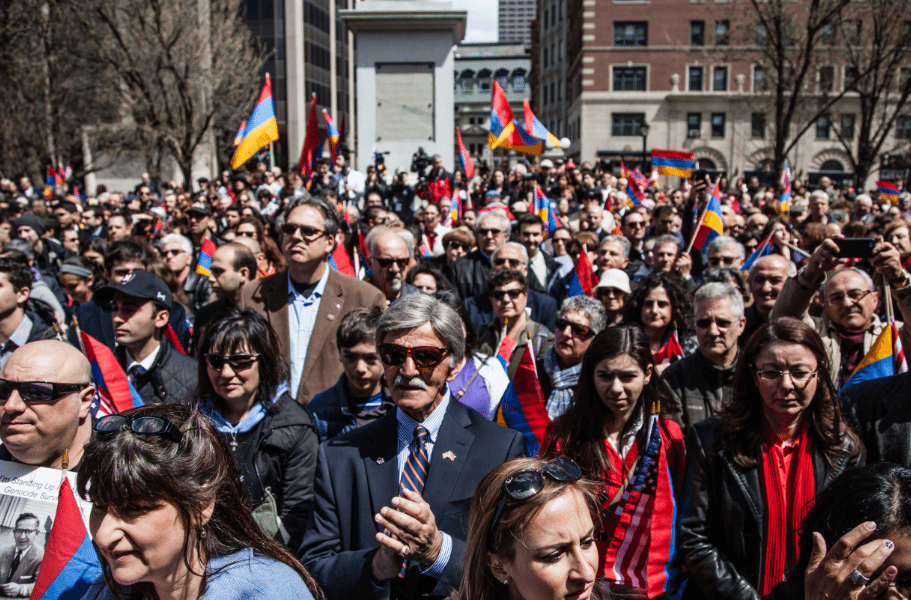On the occasion of the 100th anniversary of the Armenian Genocide, the youth of Greater Boston led their community during a vigil at the Armenian Heritage Park on April 24. Thousands of Armenians and non-Armenians braved frigid temperatures on this historic day to demand justice for the still-unrecognized crime.

Sheriff Peter Koutoujian spoke about his family’s experience in the genocide. He talked about how his grandfather escaped the genocide with his great aunt, how he found safety behind the retreating French cavalry, and how he trekked through freezing temperatures and snow, all the while shaking his sister so she would not fall asleep because he knew that if she did, she would die. A product of his environment, Koutoujian noted the tireless work he and his family have taken part in to maintain their Armenian identity—going to Armenian school board meetings and enrolling his children in Sayat Nova, ACYOA, and Sunday School, a schedule shared by many members of the Armenian-American community. He encouraged the thousands of youth members present to take up careers in business, government, and politics, and to elect Armenians to public office so our cause becomes a part of government policy.
The next to speak was Marie Carine Boggis. Like the three elderly Armenians who participated in the afternoon section of the commemoration, Boggis was also a survivor—a survivor of the Rwandan Genocide. She said that genocides are not spontaneous episodes of murder, but are part of a chain of events. She recounted her childhood in a school in Rwanda where attendance was taken by separating Tutsis from the rest of the group, and mocking them. This was the first phase in the cycle of genocide, the institutionalized racism against and the dehumanization of its soon-to-be victims. April is also the month the Rwandan Genocide began. Bogiss said that she felt hopeless during the 100 days of the Rwandan Genocide, thinking that this was normal life for many around the world, that the strong always subject the weak to oppression and mass murder. As with the Armenian Genocide, there have been reactionary accounts to the Rwandan Genocide, accusing the Tutsis of committing a counter-genocide against the Hutus. Identifying the signs of the genocide that our ancestors went through could have saved Borgiss from the trauma she endured.
***
Over a couple of months this year, Armenia, a once-obscure and tiny country, had made headlines in every major news outlet. Human rights lawyers Amal Clooney (nee Alamuddin) and Geoffrey Robertson made their statements in the European Court for Human Rights to charge Dogu Perincek of racism after his statements qualifying the Armenian Genocide as “an international lie.” Visits from the Kardashian family drew much-needed attention to our cause. Kanye West also accompanied the family along the trip, visiting monasteries, churches, and the Dzidzernagapert Genocide Memorial. West was introduced to the culture and music of Armenian at the Tumo Center for Creative Technologies in Yerevan. An impromptu concert that night at Swan Lake by West served as a makeshift cultural exchange between the West and the Near East. A hastily decided jump into the lake, an unlikely event in the U.S. due to security concerns, erased the boundaries between the hip hop pioneer and his fans, with many jumping in to embrace him.
On the eve of the Centennial, System of a Down took the stage for the Yerevan leg of their global “Wake Up the Souls” tour to raise awareness for the Armenian Genocide. The free concert drew thousands who braved the pouring rain in Republic Square. During a concert streamed live, they energized the crowd with their unique blend of Armenian-inspired alternative metal and left many in the diaspora homesick and jealous of their friends who were able to attend. Armenians around the world felt that finally, their cause was the concern of not just the descendants of the survivors but the whole of the international community.
Back in Boston, the atmosphere was triumphant and jovial. It was not one of grief and despair. There was a sense of unity among organizations and pride at the work accomplished over the past decades. Longtime community activist George Barmakian addressed the crowd, informing them of the massive advances we have made in the past 100 years. For the first time, a Turkish human rights groups, Bostonbullular, joined our community in the vigil. They expressed their condolences to the descendants of the victims and demanded the Turkish government recognize the genocide. Kurds also joined the vigil.
Barmakian concluded, “The centennial is a turning point. Now is the time for our revival. Now is the time of our rebirth. Now is the time for us to band together, to take the next step in the evolution of our people. We, the next generation, must lead the way. It starts here, it starts tonight.”
To end the vigil, Sayat Nova members spontaneously joined hands and danced to kochari. A new chapter was written for the international Armenian community, one where we are no longer victims of the genocide but victors over the extermination plans set out 100 years ago. No longer are we to remain a national question brought up nominally by major powers to pressure others in the international sphere; as Scout Tufankjian has said, we are now an exclamation point.


Bravo and God Bless you